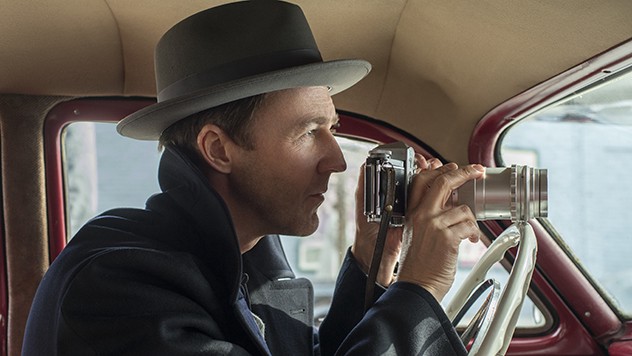Motherless Brooklyn is a 1950s New York whodunit film made by its star, Edward Norton. As with most detective films in this setting, the cast is made up of mostly white men (with a few exceptions). Many reviews of Motherless Brooklyn characterized this film as film noir. There is a debate about whether noir is a genre or a style, making it hard to define. Stylistically, Motherless Brooklyn is in the classic noir style. The debate involves classifying it as a genre. Classic noir is defined as a stylish drama with cynical attitudes and sexual motivations. In this case, the film is only noir in style. Scenes in the speakeasy in Harlem are gorgeous in lighting, pacing and tone, and the jazz music throughout the film is perfectly used.
While the cinematography is beautifully done, it is a looooooong film. There is a major event in the first few minutes, and the last thirty minutes are very exciting, but there are two hours in between. Following the storyline and all of its twists and turns is a bit confusing. I am not sure if it is hard to follow, or if I checked out because of the length.
Lionel Essrog and Neurological Disorders
Edward Norton plays Lionel, an assistant private detective with Tourette’s Syndrome and Obsessive Compulsive Disorder. When I saw this in the trailer, I was worried about how it would be handled. There were moments of comedic relief with Lionel’s ticks, but not in an offensive way. Norton handled this very gently, making sure it is not a silly gag, but instead it is a source of Lionel’s “other-ing”. The other characters do become confused by the disorders, but not necessarily hateful because of it. Beyond the reactions to these ticks, the disorders are presented as what they are — neurological disorders and not mental disorders. Lionel is smart and quick, and his disorders are helpful in his line of work. Because of his childhood and his disorders, he is better able to accept the information given to him as he dives deeper into the racist deceit of city politics.
Laura Rose
Laura Rose is no damsel in distress. Played by Gugu Mbatha-Raw, Laura is a smart, savvy, strong and informed community activist and lawyer at the heart of the mystery. Another problem with the length is we don’t get to know her until an hour deep in the movie. Instead of learning of this corruption and being a victim of it for Lionel to rescue, she is well aware of the problems with the city government and is vocal about the racism involved. Laura teaches Lionel about the situation that his city is in and shows him the racist infrastructure. Mbatha-Raw’s performance is the best of the film. Laura is well-rounded — sensitive and strong, with true emotional depth. She isn’t stereotypical in her femaleness or her Blackness, which is thanks to both the writing and her acting.

The Power Broker (spoilers)
Alec Baldwin’s character is named Moses Randolph, a not-so-far reach from Robert Moses, the real-life New York power broker. From the 1930s to the 1960s, Robert Moses held various positions in New York City government, and famously created parks, beaches and bridges which overtly oppressed the non-white residents and neighborhoods of New York. Motherless Brooklyn is putting the spotlight back on this real-life villain. In the film, Randolph is completely evil. His admission in the end of the film that he raped Laura’s mother was a necessary addition. When hearing that, the audience can stop false narratives created by a white supremacist culture that White men in power had completely consensual relationships with Black women throughout history. Purposefully or not, this film is a nod to the #MeToo movement. While thus far Randolph has been unaffected by his evil doings, we receive a payoff at the very last minute of the film, and it feels great.

Conclusion
“Time to pick a side.”

As I mentioned earlier, the cast of Motherless Brooklyn is mostly made up of white men. However, it is the white men who are ruining everything. Most of them are corrupt and self-centered. The smartest, most trustworthy character is Laura Rose, a Black woman. The viewers are actually witnessing Lionel become “woke” through the course of this long film. The story is relevant today, especially in one of the final narrative lines: “Time to pick a side.” One can either turn a blind eye to what is going on in political corruption, or you can do the right thing. Not much has changed in America since this 1950s story and, just like Lionel, we are all picking sides.

Incluvie Score: Well-rounded Black female main character; Plot revolves around the racist urban planning; Great representation of neurological disorders and “othering”
General Score: Interesting story, but long-winded; Beautifully shot in a noir style
Written by Sarah Erskine

Comments